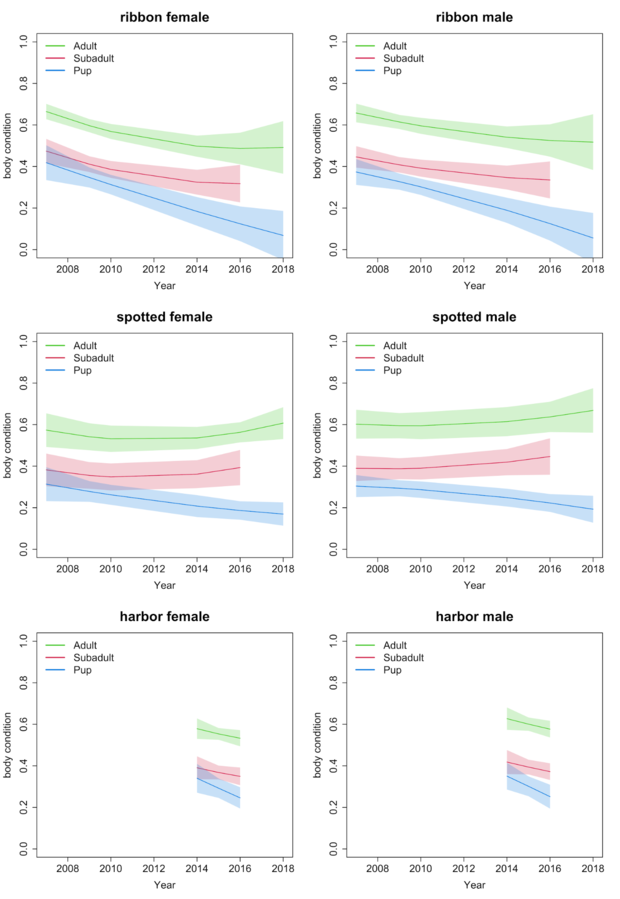The Arctic has seen rapid transformation in recent years as a result of climate change, with rising temperatures and significant fluctuations in sea ice thickness. Those changes could be causing three species of Arctic seals to lose body mass at alarming rates, according to a new study.
Researchers from National Oceanic and Atmospheric Administration (NOAA) Fisheries studied ribbon, spotted and harbor seals in the Bering Sea and Aleutian islands from 2007 to 2018. They tracked changes in how heavy the seals were in relation to their length, a metric known as “body condition.”
The researchers found that the seals’ body condition declined in almost all age and sex classes in every studied species. Only two groups, spotted seal subadults and adults, did not experience a decline in body condition.
“Our findings point strongly to climate-related impacts. We saw declines in seal condition that coincided with recent pronounced warming,” lead researcher Peter Boveng said in a statement. “Warming conditions in the Arctic seem to be affecting the condition of individual seals in a way that could impact their populations.”
For ribbon and spotted seals, the decline in body condition is likely related to their reliance on an icy environment during pregnancy and nursing cycles, the authors said. These species usually gather near the edge of sea ice in the spring to give birth between April and May, and the mothers have “very high” energy needs during this time.
Where they gather in the Bering Sea has historically had plenty of food available for that time, researchers said. But throughout the study period, sea ice decreased by 47,000 square kilometers a year — forcing the mothers to search for food in areas that may have been less favorable.
Researchers only gathered data for harbor seals between 2014 to 2016 — but they found a “striking” decrease in body condition. An average-sized individual seal, researchers said, saw a decrease in body composition of roughly 13 pounds a year. Male harbor seals weigh about 265 pounds on average, and females weigh about 220 pounds, according to the ocean advocacy group Oceana.
The study did note that the Aleutian Islands population of harbor seals have undergone a “long-term decline” between 1980 and 1999 when the population dropped by 86%. The cause of the decline is not known.
Researchers said they do not think that decline is linked to the lower body condition.
“We suspect that the recent declines in body condition during our study are an acute response to the very strong North Pacific marine heat wave,” Boveng explained, “rather than a continued chronic response to whatever has caused the long-term decline in numbers.”
The findings are especially alarming due to the species’ position on the food chain. The authors noted that climate change has often been shown to impact fish and other animals low on the food chain who are less able to switch between sources of prey as ecosystems change. But when animals like the ribbon, spotted and harbor seals — described as “resilient, long-lived predators that eat a variety of prey” — are facing physical decline, the authors wrote, “it likely reflects broad underlying ecological shifts in multiple prey species.”
During the time of the study, there were two unusual mortality events in Alaska that impacted all of the ice seals in the area, including the ribbon and spotted seals. The first event, from 2011 to 2016, revealed seals having sores, hair loss and lethargic behavior, but in good nutritional condition. No definitive cause was ever determined, researchers said.
A second event began just two years later in which large numbers of bearded, ringed and spotted seals, most of which were young or emaciated, were found stranded or dead. This mass mortality, researchers said, “strongly suggests a climate-related impact.”
The research shows a grim outlook for seal populations in these areas should temperatures continue to increase and ice continues melting, the authors said.
The Arctic saw some of its highest temperatures yet in 2020. Since the ’70s, sea ice volume has been reduced by two-thirds. Sea ice extent, areas of the ocean that have at least some of the ice, hit its lowest numbers in October.
In their study, NOAA fisheries reported that these environmental changes have been “extremely rapid,” and marine heat waves are happening more often and more intensely around the world.
“Warm conditions like those recorded in 2018 and 2019 are predicted to become more frequent,” Boveng said. “If they do, impacts from loss of sea ice on the condition of seals are likely to become clearer.”


